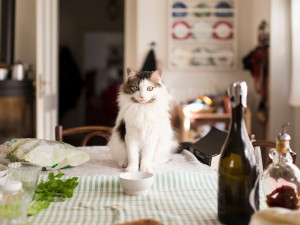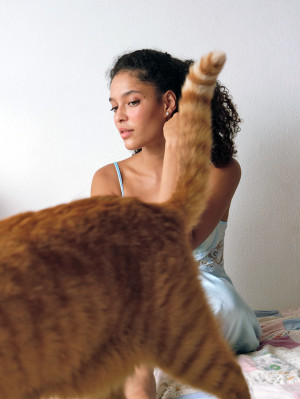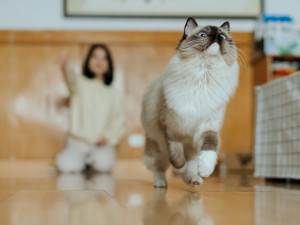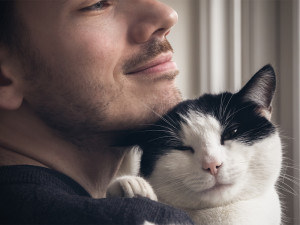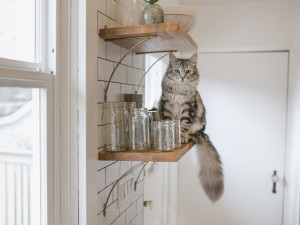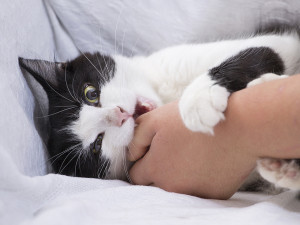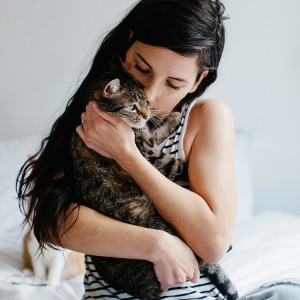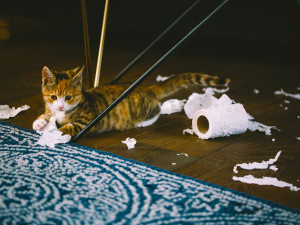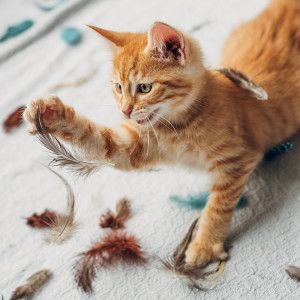Why Does My Cat Knead Me?
Among other things, “making biscuits” is a sign of affection. We’re not crying…
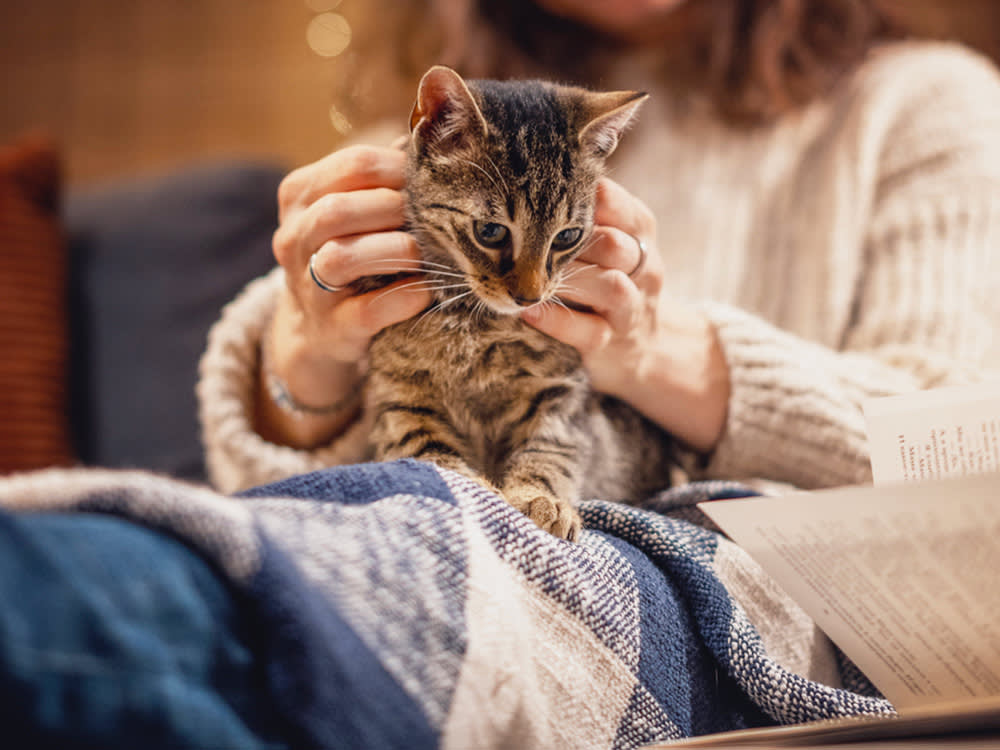
Share Article
In This Article:
Why Do Cats Knead? Is Kneading Abnormal for Cats? Tips to Stop Your Cat from Kneading
You’ve probably heard it called lots of different things — kneading, making biscuits, paddling, making muffins, happy paws, kitty massage. It’s a behavior where your cat looks like they’re stretching and clenching their paws, hence the term kneading, as if they’re kneading bread. They’ll knead on all kinds of surfaces. It can be adorable to watch but a little uncomfortable if your body is the bread, and your cat’s nails are sharp. But why do cats knead, and should you let them?
According to cat behaviorist Cristin Tamburo, while all cats may engage in kneading — which is more awesomely known as “making biscuits” — it is especially common in cats who were weaned too early.
You may even notice that your cat is sucking on items while they need them, as if they are trying to get milk from their mom. “This is a form of affection that demonstrates a close bond between the cat and human, almost as if the cat sees them as a mother figure,” Tamburo says. “In instances like this, the cat might be seeking comfort in that person’s scent and presence.”
Sure, the drooling and sucking part of the ritual may be pretty disgusting, at least for the human whose personal effects are serving as the object of the cat’s affection. Nevertheless, this behavior is, per Tamburo, a sign that the kneading cat is experiencing “maximum relaxation and contentment.”
How much do you spend on your pet per year?

Why do cats knead?
Kneading is an instinctual behavior that starts almost as soon as they’re born and can be a sign of comfort or stress.
As a kitten
Kittens knead their mother’s belly when they nurse. It’s an instinctual behavior that helps to stimulate the flow of milk. It can also leave their scent around a particular nipple, which could be part of the reasons kittens often go for the same nipple each time they nurse.
How mother cats can tolerate those incredibly sharp kitten claws is another matter. But they do. In fact, you’ll often see the mother cat kneading, sometimes freely in the air, as her kittens nurse. In those moments, they’re all feeling a sense of comfort and security. For the kittens, that’s when the association is formed between kneading and comfort.
A sign of comfort and happiness
While it doesn’t start out as a sign of comfort, the instinct to knead during nursing coincides with kittens feeling completely content. That’s how kneading becomes something cats of any age will do when feeling relaxed, secure, and comfortable. You’ll often see it when they’re lying somewhere cozy and soft, stretching and scrunching their paws on the soft fabric or your body.
Cats will also knead in the air. You may see this when they’re lying on their backs with paws reaching for the sky. Cats will also knead standing or sitting. When you come home from work, and your cat rushes to the door to greet you, they may be kneading from excitement.
Reducing stress
When we’re stressed, we tend to rely on things that bring a sense of soothing and comfort, like a cup of tea or wrapping up in a blanket. Cats do the same. In moments of stress or anxiety, they can be found using self-soothing techniques like kneading and purring to try and calm themselves.
You may notice other body language that tells you they’re feeling anxious, like fidgeting, general nervousness or skittishness, inability to let their guard down, trying to look small, hiding, etc.
Showing affection
Your cat may not be kneading on you specifically to show you they love you. What it shows is that they’re happy and feel safe and secure with you. They’re feeling that sense of comfort that brings out their kneading behavior. It’s a compliment to you that being near you and in the environment you’ve created for them makes them feel comfortable enough to knead.
Of course, we also know cats knead when anxious. If they have relaxed body language, soft eyes, and aren’t showing other signs of stress, it’s probably not anxious kneading. Knowing how to read body language can help you figure this out.
Scent marking
Interestingly, because cat’s paws have scent glands in them, kneading is also a way in which a cat may mark their territory. But in general, even cats who weren’t weaned too early will knead inanimate objects, people, or even other pets to show pleasure. Some will purr contentedly, drift off to sleep, or zen out in a hypnotic state while “making biscuits.”
Is kneading abnormal for cats?
Kneading is a completely appropriate instinctual behavior. It’s one of the first things kittens do after they’re born. Kneading serves many important purposes, from helping the flow of milk during nursing to reducing stress and helping cats relax.
Kneading can be a problem if it’s a sign of stress. Whether it’s stress from pain, fear, difficult relationships with other pets or people, or anything else, stress should be addressed.
Tips to stop your cat from kneading
Stopping your cat’s kneading completely is not a great idea. It’s also unnecessary. This instinctual behavior is important. However, there may be certain times or locations where you’d prefer your cat not knead, like in the middle of the night on your head. In those cases, you can work on redirecting that behavior.
First, consider the reason for the kneading. Is your cat relaxed or anxious? Could they be using kneading to get your attention? For example, if you’re sound asleep and your cat learns that kneading on your leg wakes you up and triggers you to pull them to your chest for a cuddle, the kneading may be more about getting that attention.
In the case of attention, you need to show your cat that kneading doesn’t get them anything. When they knead you at that moment, for that reason, ignore it. It may get worse at first. But the behavior should fade out in time. It’s important to meet your cat’s need for that snuggle attention without them having to ask and, if needed, at a better time for you. Make the snuggle session a bedtime or wake-up routine instead of the middle of the night.
If your cat is relaxed and kneading, neutrally interrupt that behavior. It’s not attention from you. It’s a distraction that’s neither good nor bad. It just interrupts the kneading for a moment. Then, you can move the item you don’t want to be kneaded or lure your cat away. And when they knead other things instead, reward them with some attention to reinforce that behavior.
It can also help to move the item to a different area permanently. For example, if you have a family heirloom quilt where your cat likes to sleep, it’s more likely to be an object for kneading. If you move it to the chair where your cat never sleeps, it’s out of the line of fire.
If your cat is kneading due to a stress/anxiety trigger, you want to try to identify the trigger and remove it or help them feel better about it to reduce that stress response.
FAQs (People also ask):
Is my cat kneading a sign of affection?
Your cat’s kneading can absolutely be a sign of affection in that they’re happy, relaxed, and comfortable with you and slip into their instinctual relaxed kneading behavior as a result.
Does kneading mean my cat is happy?
Kneading often means your cat is happy and feels secure. However, it can also be a self-soothing behavior they do when they’re feeling anxious. Look at the context and your cat’s body language for signs of stress or anxiety.
How can I read my cat’s body language?
Reading your cat’s body language can take a little practice. They are masters at subtle communication using their tails, ears, and even the shape of their faces. Check out our article on body language to learn more about how to read and respond to it.
Why does my cat knead me but not my partner?
Your cat may choose to knead one person over another for many reasons. It can be the location where that person is sitting, the squishiness and comfort of the fabrics they’re wearing, the time of day that person sits down to relax, and many more reasons. It’s not necessarily about preferring one person over another, though that can play a role.
Why does my cat knead me with claws?
A cat’s claws naturally extend when they knead. It’s not an intentional effort to dig their claws into you. It’s just part of the kneading process.

Robb Fritz
Robb Fritz is a writer, digital editor, producer, and content creator. He has previously written for McSweeney’s Internet Tendency where he penned a column entitled “History’s a Bitch: A Dog Walk Through Time.” He is now expanding his writing to include cats, which makes sense as he lives with two of them, along with his wife and daughter. They recently moved from LA to the much smaller town of Fairfield, Iowa, where they are surrounded by deer, geese, and a lot of cottontail.

LeeAnna Buis, CFTBS, FFCP
LeeAnna Buis has adored cats her entire life and thought she knew them inside out and sideways. But it wasn’t until she worked with a feline behavior consultant that she fully understood how incredible, complicated, and inspiring they really are. She made a career change, starting the certification process to become a behavior consultant right away. She discovered what unique, fascinating, complex creatures cats are and knew this was what she wanted to do with her life — help others on a similar journey to truly knowing, loving, and appreciating their cats.
LeeAnna earned her certification through Animal Behavior Institute, where she received the certified feline training and behavior specialist (CFTBS) designation.
Related articles
![cat snuggling man]()
What’s Your Cat’s Love Language?
Five surprising ways cats show affection (and how you can show it back), according to a cat behaviorist.
![A cat sitting on a shelf with glassware.]()
Why Do Cats Knock Stuff Over?
Your brand new iPhone, antique figurine, full glass of water—they will swat it off the table. A cat behaviorist explains why.
![cat biting person's hand]()
Why Does My Cat Bite Me?
Don’t live in fear of your feline overlord.
![dark-haired woman hugging cat that has imprinted on her]()
10 Signs Your Cat Has Imprinted on You
Feeling like you have a little shadow these days? Here’s why that’s happening.
![A calico tabby kitten chewing and tearing a roll of toilet tissue.]()
Why Does My Cat Chew On Everything?
How to decode your cat’s chewing habits when they’re nibbling on all the things.
![A cute orange tabby kitten playing with feathers.]()
Is Orange Cat Behavior Real? The Truth Behind the TikTok Trend
Your TikTok algorithm would like you to think so, but the experts weigh in.


